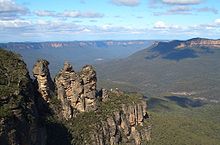Three Sisters (Australia)

The Three Sisters (German "Drei Schwestern") are a rock formation in the Blue Mountains of New South Wales , Australia . They are located approximately 110 kilometers from Sydney and 2.5 kilometers from Katoomba .
Emergence
The Three Sisters emerged from the stratigraphic formation of the Narrabeen Group about 200 million years ago. They lie in a sedimentary basin , the so-called Sydney basin . On the Three Sisters, the horizontally stored layers of sandstones , which have been exposed to the weather, can be clearly seen. This rock has deposited and solidified in an original river landscape. The rock towers of the Three Sisters were created by erosion : the poorly cemented quartz grains of this sandstone were eroded by wind, rain and water; vertical fissures were created until boulders broke off and the columnar Three Sisters remained. Another four stumps can be seen, so that there were probably 7 "sisters" in the past.
The orange color comes from an iron oxide, limonite .
Location and naming
The Three Sisters are located near the town of Katoomba above the Jamison Valley and are one of the most famous landmarks of the Blue Mountains. Their names are Meehni (922 m), Wimlah (918 m, also called Weemala in numerous sources ) and Gunnedoo (906 m).
Dream time
An Australian Aboriginal Dreamtime legend has it that the three sisters Meehni, Wimlah, and Gunnedoo lived here with their father, Tyawan, a wizarding doctor. The bunyip they were afraid of also lived nearby .
One day Meehni was frightened when she saw a millipede and threw a stone at it, but it rolled over the cliffs. Bunyip woke up and was angry; when he saw the sisters, he went furiously at them. Tyawan took his magic bone and turned the three sisters standing close together into three rock towers to protect them.
The bunyip now turned against Tyawan, who turned himself into a lyre- tail and flew away. In the process he lost his magic bone, which he is still looking for today; the three sisters are waiting and hope that he will find him soon.
Aboriginal heritage
Up until the turn of the millennium, the Three Sisters had been climbed; there are 19 climbing routes between 31 and 180 meters in altitude. They may no longer be climbed. At the Three Sisters the areas of the Aboriginal tribes of the Gundungarra and Darug overlap . In the first years after 2000, climbing and paragliding in the area of the Three Sisters was banned out of respect for Aboriginal traditions. An exact date cannot be determined. The Elder Aunt of Darug Joan Cooper is quoted as saying that she does not mind if the first two sisters are climbed, only the third is sacred.
On October 19, 2014, the state of New South Wales declared the Three Sisters an Aboriginal Heritage Place. The Elder Aunty of Gundungarra Merle Williams remembers that her father was born in the valley at the foot of the Three Sisters and secretly keeps the memory of the incisions and paintings that tell the story of the place. The appointment to an Aboriginal site brings "recognition of their cultural heritage and the right to consultation when projects are to be realized".
Others
The Three Sisters can be viewed from the neighboring Echo Point , a large viewing platform. The platform, on which there is a souvenir shop and next to which there is a shop with a restaurant, allows a view of the Jamison Valley below . Not far from the platform is the Scenic Skyway cable car station , which runs across the valley. You can get to the rock towers on a hiking trail that continues down the Giant Stairways into the valley. From the nearby town of Katoomba, there is a bus route to Echo Point .
Individual evidence
- ^ Department of Mineral Resources (1997) Layers of Time. The Blue Mountains and their Geology ISBN 0-7313-0274-5 , page 19
- ^ National Parks and Wildlife Service (2002) The Blue Mountains , 14
- ↑ The Crag, database for climbing routes (English), accessed on October 7, 2015
- ↑ Among the Aborigines, the knowledgeable keepers of tradition are called Elder and are respectfully addressed as Uncle (Uncle) or Aunty (Aunty)
- ↑ Laef Hosking, in the commentary on his climbing video from 1995 on Youtube English, accessed on October 7, 2015
- ↑ Three Sisters in the Blue Mountains declared Aboriginal heritage site , on Sydney Morning Herald, January 19, 2014, accessed October 7, 2015
Web links
Coordinates: 33 ° 44 ′ 8 ″ S , 150 ° 18 ′ 52 ″ O

